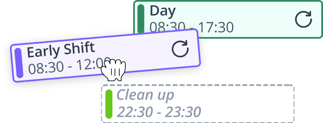In this guide, we’ll break down what predictive scheduling really means, why it matters for employers, and how to stay ahead of the rules.
What is predictive scheduling?
Imagine always knowing your work shifts weeks ahead—no last-minute surprises, no texts the night before asking you to cover a shift. That’s the idea behind predictive scheduling.
It’s a law (in some places) and a best practice (pretty much everywhere) that says: Give your team fair notice about their work schedules.
In simple terms, it means employers must:
-
Share work rotas in advance (usually 7–14 days ahead)
-
Pay extra if they make changes last minute
-
Avoid calling staff in for surprise shifts without warning
It’s also known as a Fair Workweek in parts of the US—same thing, just a different label.
Why does this matter? Because unpredictable schedules are stressful. For employees, it means scrambling for childcare, missing out on second jobs, or rearranging life every week. For employers, it can mean unhappy staff, high turnover, and even legal trouble if you’re in a city or country with these laws in place.
💡Quick tip: Predictive scheduling isn’t just about being “nice”—in some places like New York City, San Francisco, and soon the UK, it’s the law.
What does the law say about predictive scheduling?
Let’s break it down—because the rules depend on where your business is based.
🇺🇸 In the United States
There’s no federal law (yet) on predictive scheduling. But don’t breathe easy just yet—many cities and states have their own rules, especially if you’re in retail, hospitality, or food service.
Here are a few key ones:
| Location | Advance Notice Required | Predictability Pay? | Other Rules |
|---|---|---|---|
| New York City | 14 days | Yes | Applies to fast food and retail chains |
| San Francisco | 14 days | Yes | Affects retail with 40+ locations |
| Chicago | 14 days | Yes | Covers health care, hospitality, more |
| Seattle | 14 days | Yes | Also requires a rest period between shifts |
| Oregon (statewide) | 7 days (14 by 2025) | Yes | Covers employers with 500+ employees |
✅ Predictability pay = Extra pay when you cancel, shorten, or add shifts last minute.
If you're operating in more than one city or state, things can get messy. Best to check local laws or use compliance-ready scheduling software.
🇬🇧 In the United Kingdom
Predictive scheduling is newer here—but it’s catching up fast.
As of September 2024, the Workers (Predictable Terms and Conditions) Act gives employees the right to request a more predictable work pattern if they’ve been with you for at least 26 weeks.
It’s especially important for:
-
Zero-hours contract workers
-
Casual or agency staff
-
Shift-based roles (like retail, care, or cleaning)
Here’s what you need to know:
-
Employees can make two requests per year
-
You must respond within a month
-
You can only refuse if you have a valid business reason (e.g. the work just isn’t available)
This is part of a bigger push to make work more stable and fair—especially for people in insecure jobs.
What are your responsibilities as an employer?
If you're managing shift-based teams, you’ve got a few big boxes to tick when it comes to predictive scheduling. Whether you're doing it by law (US/UK) or just to keep your staff happy, these are the essentials:
🗓️ 1. Give plenty of notice
Most laws require that you publish schedules 7 to 14 days in advance.
That means:
-
No more texting shifts the night before
-
Rotas should be posted where everyone can see them (physically or digitally)
-
If something changes last minute, you might owe predictability pay
💡Even if you're not legally required to, doing this builds trust—and reduces “Sorry, I can’t make it” messages.
💸 2. Pay up for last-minute changes
This is called predictability pay. It kicks in when you:
-
Cancel a shift close to the date
-
Cut someone’s hours after scheduling them
-
Ask someone to come in on their day off
🧾 In the US: the amount varies by city (e.g. 1–4 hours' pay).
🇬🇧 In the UK: there's no pay requirement yet, but refusing someone’s request for predictable work without solid reasons can backfire—legally and reputationally.
📁 3. Keep good records
Yes, paperwork (or digital logs) matters here. You’ll want to track:
-
When schedules were posted
-
Any changes made (and why)
-
Proof of predictability pay, if owed
-
Employee requests for changes
🔐 Good record-keeping = protection if disputes or audits pop up.
🗣️ 4. Be fair with shift distribution
Avoid always giving the best shifts to the same people. Predictive scheduling also ties into fairness and equality. If someone’s always stuck with weekends and no notice, that’s a red flag.
📬 5. Respond to schedule requests properly
Under the UK’s new law, workers can request predictable work patterns, and you have to:
-
Reply within a month
-
Offer a meeting if you're saying no
-
Give a clear reason for refusal (e.g. lack of available hours, role not suited to a fixed pattern)
Here is a quick reference table to show you the do's and don’ts 👇
| Task | ✅ Do this | ❌ Don’t do this |
|---|---|---|
| Publish rotas in advance | 7–14 days before shifts | Post shifts the night before |
| Change shifts last-minute | Offer predictability pay | Cancel without compensation |
| Handle staff requests | Respond in 1 month (UK) | Ignore or delay responses |
| Record schedule info | Save changes & dates | Rely on memory or casual notes |
Scheduling software and predictive scheduling laws
Keeping track of rotas, shift changes, and who's available when is enough to make anyone’s head spin. That’s where technology steps in.
Good scheduling software doesn’t just keep you compliant. It helps you work smarter, not harder.
Smarter planning, fewer surprises
Modern scheduling tools can:
-
Auto-generate rotas based on availability, contract hours, and business needs
-
Alert you when a shift change triggers predictability pay (so you don’t forget)
-
Track when schedules were published (for compliance records)
-
Show you if someone’s about to work back-to-back shifts (which may not be allowed in some regions)
💡 Some even give you a heads-up if you’re about to break the law. Handy, right?
Empower your team with mobile access
Most platforms let employees:
-
Check their rotas anytime, anywhere
-
Get notified when shifts are updated
-
Submit time-off requests or changes
-
Swap shifts (with approval, of course)
It saves everyone time—and a ton of “Can I see the rota?” messages.
Automatic record-keeping
Compliance is way easier when everything’s logged automatically. A solid system can keep track of:
-
Who was scheduled, when
-
Any edits or updates made to shifts
-
Proof of when rotas were shared
-
Pay adjustments linked to shift changes
No more digging through emails or trying to remember what happened last Thursday.
Sync with payroll and HR
The best platforms sync scheduling with payroll, so predictability pay, overtime, or late cancellations are calculated without you needing to pull out a calculator.
And if your HR system is connected, it means:
-
Employee availability stays up to date
-
Leave requests and public holidays are factored in automatically
-
Contract terms are always respected
✅ Quick checklist: What to look for in predictive scheduling software
| Must-Have Feature | Why it matters |
|---|---|
| Shift alerts and change tracking | Helps you avoid last-minute surprises |
| Mobile access for staff | Boosts transparency and engagement |
| Compliance flags (US/UK laws) | Keeps you on the right side of the law |
| Predictability pay calculations | Saves time and errors in payroll |
| Audit-friendly records | Protects you if challenged |
| Integration with HR/payroll tools | Reduces manual work |
💡Useful Read: What’s The ROI of Rota Software? Savings, Benchmarks & Calculator
How Shiftbase makes predictive scheduling a breeze
Trying to manage rotas, last-minute changes, and compliance rules with spreadsheets? That’s a fast track to frustration.
With Shiftbase, you get all the tools you need to stay ahead of predictive scheduling laws and keep your team in the loop—without chasing your tail.
Here’s how we help:
-
Employee scheduling: Build and publish rotas in minutes. Easily set rules for availability, shift preferences, and contract hours so you’re not guessing who can work when.
-
Time tracking: Know exactly who worked what hours, and keep a tidy record in case you ever need it.
-
Absence management: See holidays, sick leave, and approved time off at a glance—no surprises when it’s time to fill the schedule.
You’ll spend less time fixing rota mistakes and more time running your business. Oh, and your team? They'll actually know when they're working (and get to plan their lives accordingly). Win-win.
🎯 Ready to stop winging it with your rotas?
Give Shiftbase a go—start your free 14-day trial here and see how easy predictive scheduling can be.




